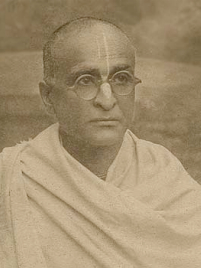Swedish Scholar Recognizes Bhaktisiddhanta’s Unique Contributions
By Eurasia Review | Фев 20, 2010

Traditional and modern Hinduism have an extensive monotheistic (belief in one God) branch that in many ways can be compared with the Christian notion of the person and a personal relationship to God. This is in spite of the the fact that Hinduism is often portrayed as being characterized by spiritual non-dualism and polytheism, or the belief in multiple gods.
This is the result of new research in religious studies at the University of Gothenburg.
The research focuses on the Indian religious reformer Bhaktisiddhanta Sarasvati (1874-1937), who was a key figure for a number of modern religious institutions such as the Hare Krishna movement.
In his research, Ferdinando Sardella presents the theory that Sarasvati’s philosophy and religious vision were permeated by the concept of a spiritual or non-material personhood. It motivated and inspired his struggle against the limitations of the caste system and the religious dominance of the brahmin orthodoxy, as well as his vision for a spiritual reform of the modern world.
Regarded Christianity as a partner
It also gave him the opportunity to regard the major monotheistic traditions in the world, such as Christianity, as partners that inspired his philosophical struggle against those who opposed a person-centered perspective on life.
“One of the most interesting results of my research is that Sarasvati represents a countercurrent to more well-known Hindu non-dualists such as Mahatma Gandhi and Swami Vivekananda,” says Ferdinando Sardella.
Ferdinando Sardella has studied Sarasvati’s background, life and philosophy, since his movement served as the basis for the creation of a modern institution that was originally known as the Gaudiya Math. The movement has a number of contemporary offshoots, the most noticeable being ISKCON, popularly known today as the Hare Krishna movement, which was founded in 1966 in New York by Swami Bhaktivedanta.
Established centers abroad
The missing piece of the puzzle has been the relatively unknown Bhaktisiddhanta Sarasvati, whose vision and ideas provided the original impulse for these new movements, and who established centers in both London and Berlin during his lifetime.
“His work with the Gaudiya Math meant that Sarasvati’s voice gradually acquired a prominent position in India. Despite this, his movement broke up following his death in 1937 due to a number of internal conflicts, and it seemed as though his ideas would soon be forgotten. But they were rekindled during the 1960s through the work of Swami Bhaktivedanta,” says Ferdinando Sardella.
The study is based on written historical material in Bengali, English and German. It fills a gap in the history of modern Hinduism as well as the early interaction between Hinduism and Europe.















